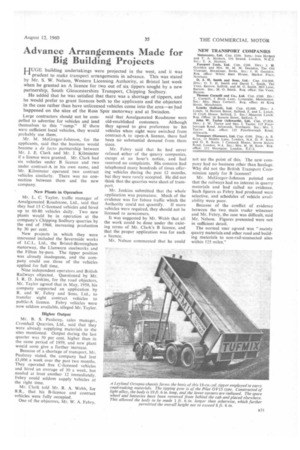Advance Arrangements Made for Big Building Projects
Page 39

If you've noticed an error in this article please click here to report it so we can fix it.
f4 UGE building undertakings were projected in the west, and it was prudent to make transport arrangements in advance. This was stated by Mr. S. W. Nelson, Western Licensing Authority, at Bristol last week
when he granted an A licence for two out of six tippers sought by a new partnership, South Gloucestershire Transport, Chipping Sodbury.
He added that he was satisfied that there was a shortage of -tippers, and he would prefer to grant licences both to the applicants and the objectors in the case rather than have unlicensed vehicles come into the area—as had happened on the sites of the Ross Spur motorway and at Swindon.
Large contractors should not be compelled to advertise for vehicles and lend themselves to this "ramp." If there were sufficient local vehicles, they would probably use them.
Mr. M. McGregor-Johnson, for the applicants, said that the business would become a de facto partnership between Mr. J. E. Clark and Mr. J. Kilminster if a licence were granted. Mr. Clark had six vehicles under B licence and two under contract-A in his own name, and Mr. Kilminster operated two contract vehicles similarly, There was no connection between them and the new company.
New Plants in Operation Mr. L. C. Taylor, traffic manager of Amalgamated Roadstone, Ltd., said that they had 15 C-licensed vehicles and hired up to 60-80 vehicles daily. Two new plants would be in operation at the company's Chipping Sodbury quarries by the end of 1960, increasing production by 30 per cent.
New projects in which they were interested included the Severnside works of I.C.I., Ltd., the Bristol-Birmingham motorway, the Llanwern steelworks and the Filton by-pass. The tipper position was already inadequate, and the company could use three of the vehicles applied for full time.
Nine independent operators and British Railways objected. Questioned by Mr. I. R. D. Jenkins, for the road objectors, Mr. Taylor agreed that in May, 1959, his company supported an application by R. and W. Febry and Sons. Ltd., to transfer eight contract vehicles to public-A licence. Febry vehicles were now seldom available, alleged Mr. Taylor.
Higher Output
Mr. B. S. Paulsrey, sales managei, Cromhall Quarries, Ltd., said that they were already supplying materials to the sites mentioned. Output during the last quarter was 50 per cent, higher than in the same period of 1959, and new plant would soon give a further increase.
Because of a shortage of transport, Mr. Paulsrey stated, the company had lost £1,000 a week over the past two months. They operated five C-licensed vehicles and hired an average of 30 a week, but needed at least another 12 immediately. Febry could seldom supply vehicles at the right time.
Mr. Clark told Mr. R. A. Webb, for B.R., that his B-licence and contract vehicles were fully occupied.
One of the objectors, Mr. W. A. Febry, said that Amalgamated Roadstone were old-established customers. Although they agreed to give preference to his vehicles when eight were switched from contract-A to open-A licence, there had been no substantial demand from them since.
Mr. Febry said that he had never refused either of the quarry companies, except at an hour's notice, and had received no complaints. His concern had telephoned many hundreds of times offering vehicles during the past 12 months, but they were rarely accepted. He did not think that the quarries were short of transport.
Mr. Jenkins submitted that the whole application was premature. Much of the evidence was for future traffic which the Authority could not quantify. If more vehicles were required, they should not be licensed to newcomers.
It was suggested by Mr. Webb that all the work could be done under the existing terms of Mr. Clark's B licence, and that the proper application was for such a licence.
Mr. Nelson commented that he could
not see the point of this. The new company had no business other than haulage. Why did not the British Transport Commission apply for B licences?
Mr. McGregor-Johnson pointed out that the railways had no interest in quarry materials and had called no evidence. Such figures as Febry had produced were selective, and schedules of vehicle availability were poor.
Because of the conflict of evidence between the two main trader witnesses and Mr. Febry, the case was difficult, said Mr. Nelson. Figures presented were not in sufficient detail.
The normal user agreed was "mainly quarry materials and other road and building materials to non-rail-connected sites within 125 miles."
















































































































